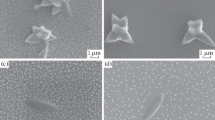Abstract
Partly oxidized copper films were annealed in a controlled vacuum of 10−7 Pa at a temperature of 450° C. The changes discussed below were observed in situ with a specially designed high-resolution transmission electron microscope. The thin, (100)-oriented, single-crystal films of copper had been oxidized immediately prior to the annealing studies at the same temperature and at an oxygen partial pressure of 7×10 −1 Pa, until the desired fraction of the copper film was converted to oxide. It was observed that the oxide disappeared during annealing as long as some copper was left unoxidized. The disappearance of the oxide is explained as being due to dissociation of the oxide at the oxide-metal interface followed by diffusion of oxygen into the metal and desorption of oxygen from the surface of the unoxidized copper. The rate of disappearance of the oxide was found to be proportional to the surface area of unoxidized copper, i.e., the desorption was found to be the rate — limiting step. In the case of heavily oxidized films (>50%), holes were observed to develop in the oxide near the oxide-metal interface after an annealing period of 2–3 hr. Upon resumption of the oxidation, these holes first disappeared, and the normal oxidation behavior was then resumed. The formation of holes may be explained by vacancy clustering. When completely oxidized films were annealed, recrystallization of the oxide was observed.
Similar content being viewed by others
References
G. W. Simmons, D. F. Mitchell, and K. R. Lawless,Surf. Sci. 8, 130 (1967).
K. Heinemann, D. Bhogeswara Rao, and D. L. Douglass,Oxid. Met. 9, 379 (1975).
K. Heinemann, D. Bhogeswara Rao, and D. L. Douglass, Proc. 33rd EMSA Meeting (1975), p. 48.
F. Gronlund and J. Bénard,C.R. 240, 624 (1955).
M. Hansen and K. Anderko,Constitution of Binary Alloys (McGraw-Hill, New York, 1958).
R. L. Pastorek and R. A. Rapp,Trans. Metall. Soc. AIME 245, 1711 (1969).
A. Phillips and E. N. Skinner,Trans. Metall. Soc. AIME 143, 301 (1941).
C. E. Ranseley,J. Inst. Met. 65, 147 (1939).
R. M. Dell, F. S. Stone, and P. F. Tiley,Trans. Faraday Soc. 49, 195 (1953).
S. Smoes, F. Mandy, A. Vander Auwera-Mahieu, and J. Drowart,Bull. Soc. Chim. Belg. 81, 45 (1972).
JANAF Thermochemical Tables, D. R. Stull, ed. (Dow Chemical Co., Midland, Mich., 1967).
D. F. Mitchel and K. R. Lawless, Proceedings of the Paint Research Institute, 43rd Annual Meeting of the Federation of Societies for Paint Technology, Atlantic City, N.J. (October 29, 1965).
P. Kofstad, inNonstoichiometry, Diffusion, and Electrical Conductivity in Binary Metal Oxides (Wiley-Interscience, New York, 1972), p. 328.
Author information
Authors and Affiliations
Additional information
This work was performed at the Ames Research Center and funded by NASA Grants Nos. NCA2-OP390-403 and NSG-2025.
Rights and permissions
About this article
Cite this article
Bhogeswara Rao, D., Heinemann, K. & Douglass, D.L. Oxide removal and desorption of oxygen from partly oxidized thin films of copper at low pressures. Oxid Met 10, 227–238 (1976). https://doi.org/10.1007/BF00618245
Received:
Revised:
Issue Date:
DOI: https://doi.org/10.1007/BF00618245



